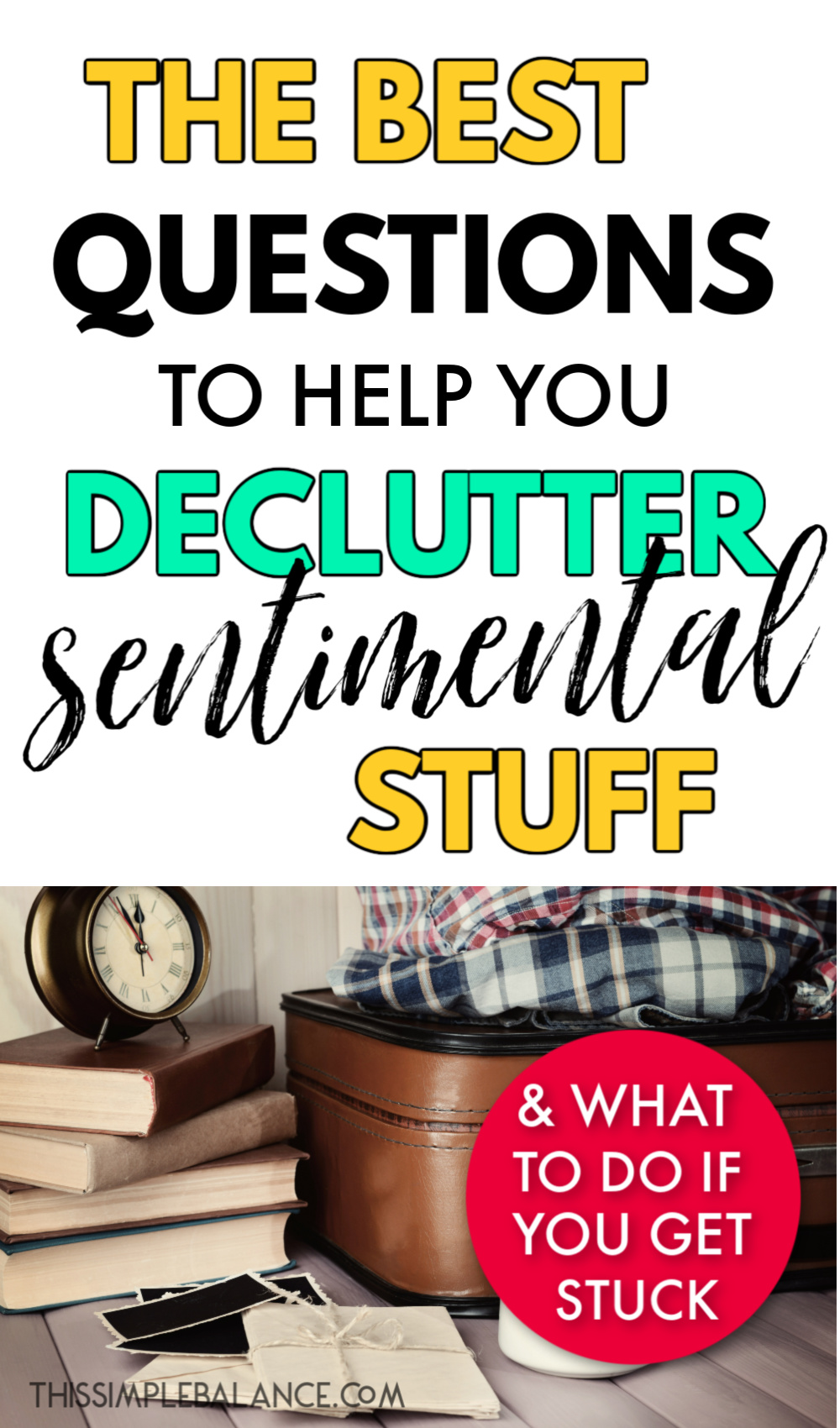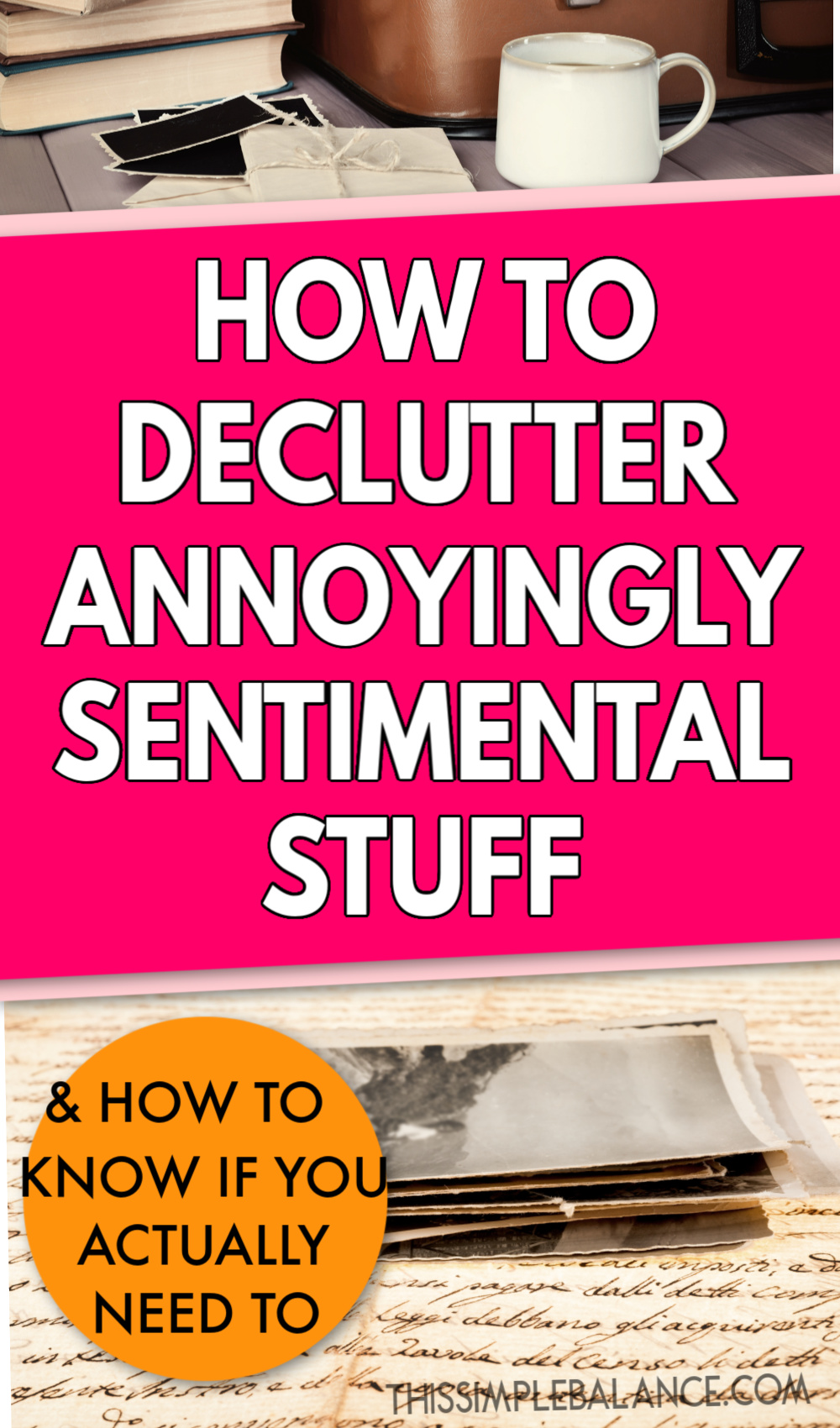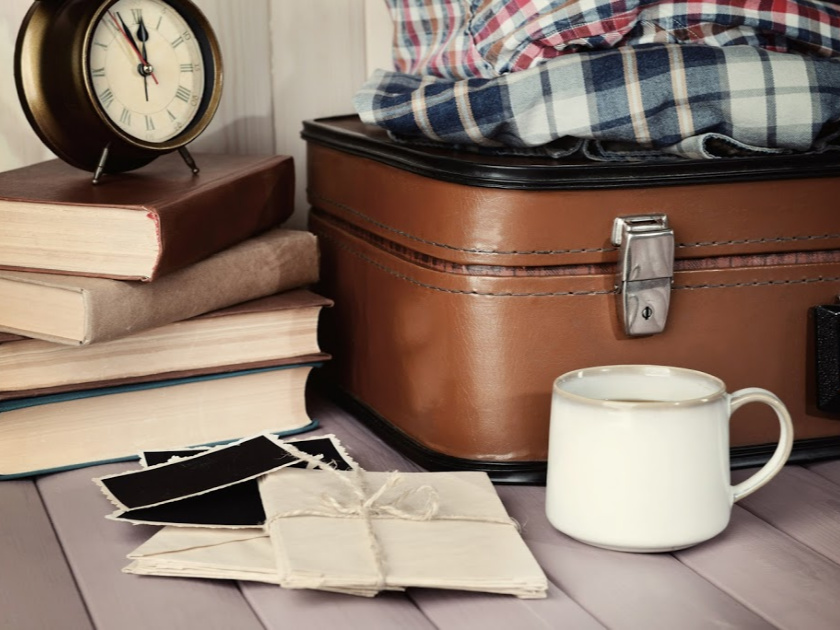Inside: Physical items you are emotionally attached to are often the hardest things to get rid of. Make decluttering sentimental items easier with these 6 questions, plus what to do if you get stuck.
Before my dad passed away unexpectedly, I didn’t understand why people struggled to part with sentimental clutter.
The practical things? I could totally get that.
Try to getting me to part with any of my pretty baskets that help keep all the stuff required to care for five little humans from getting completely out of control, and I’ll cry like a baby and tell you semi-politely to BACK.UP.OFF.
But that blanket you don’t use anymore and don’t even like, so it’s sitting in a storage closet?
Me: “So you don’t like it? Could you give it away?”
You: “No, I could never get rid of it. My cousin Mary knit it herself…we used to be close.”
Me: “Oh. Are you still close?”
You: “Well, no, we haven’t spoken in more than ten years.”
Me: “So maybe you could declutter it?”
You: “I don’t think so. We were so close back then, and it reminds me of those good times.”
[Blanket goes back to the deep, dark, closet.]
Scenarios like this one left me completely dumbfounded before. I just didn’t understand.
All that changed when my dad died.
You Might Also Like: Quick & Easy Decluttering Tips for Fast Progress
Decluttering Sentimental Items Is HARD Work
THIS POST PROBABLY CONTAINS AFFILIATE LINKS. AS AN AMAZON ASSOCIATE, I EARN FROM QUALIFYING PURCHASES. YOU CAN READ OUR FULL DISCLOSURE POLICY HERE.
Thirty minutes after I got that call, I dug through a nasty recycling bin to find the mini-golf score card from the game we played the week before he died.
I cleaned that nasty score card off and let it dry.
And I finally understood. I get it now.
Decluttering sentimental items is so dang difficult because you feel like it’s the only tangible thing you have to remind you.
Those things remind you of some of the best times, the best people, the best experiences.
I know other minimalists will tell you that memories live in our minds, not in physical things. While I know that theoretically it’s true, I wonder if the people who write those things are sentimental people or if they’ve ever experienced loss.
I want you to know that decluttering sentimental items is HARD. And I get that.
There’s a reason Marie Kondo saved sentimental items for last, y’all.
I’m also not going to tell you that you HAVE to get rid of anything.
But if you clicked on this post and you’re reading it now, you probably know that keeping every single item that has ever held sentimental value to you is NOT serving you anymore.
Something about it is bothering you.
Hanging on to all that stuff is preventing you from living your life right NOW.
And that’s why decluttering sentimental items is important.
So now that you know I totally get it, and that I’m not going to make you do anything you’re not ready to do, let’s jump into how to actually start making real progress with the hardest category to declutter: sentimental stuff.
Read More: 7 Best Decluttering Tips from Organization Guru Marie Kondo

Before Decluttering Sentimental Items: 3 Things To Do Before You Start
1. Realize you don’t necessarily need to get rid of any of it.
Say whaaaaat? Yes, you read that right.
Maybe your sentimental items aren’t clutter for you. And maybe you don’t need to get rid of any of it.
Minimalism doesn’t say you need to throw away all the stuff that holds memories for you.
What minimalism does suggest is that you need to honor your present and live in that present. It also encourages you to be intentional with everything you keep in your home.
And if your possessions from your past are getting in the way of you living the life you want to be living right NOW? Well then yes, those sentimental items you’re hanging onto ARE a problem.
But what if your sentimental things aren’t really a problem?
If the sentimental stuff isn’t taking over your house, and it’s all in a nice neat container used to define how much you can keep (so you know when you need to start getting rid of some stuff)?
If those sentimental items aren’t affecting your thought life, and aren’t causing you (or your family, I might add) any anxiety whatsoever?
Then you might not even need to get rid of a single sentimental thing.
Really.
Please do not feel pressured to get rid of all your sentimental items just for the sake of it.
If you want to declutter them, do it. But do it because they are no longer serving you, not because you think you have to.
2. Assess the magnitude of the problem.
Here’s the thing. Maybe you’ve decluttered your entire house except the sentimental stuff.
And you’ve been anxious about it. Thinking how hard it’s going to be to part with it.
But back to the first point: is it really a problem?
Let me ask you a few questions:
- Do you have an entire room dedicated to your sentimental items?
- Is there a closet you can’t open because it’s overflowing with sentimental stuff?
- Does it negatively affect your life in any way?
If you have an entire room or an entire closet in your home that you can’t use because of sentimental items, then yes, you do probably need to declutter that stuff.
OR.
Maybe the number of physical items isn’t huge. Maybe it’s HOW it’s negatively affecting you mentally and emotionally.
If your sentimental items are adding to your “mental load” as Denaya of Simple Families would put it, you definitely need to declutter them.
Adding to your mental load looks like:
- Constantly debating whether or not you need to declutter your sentimental items.
- Feeling guilty for keeping things that you never use or look at, but can’t seem to get rid of.
- Reminding you of times, people, experiences, but not in a good way – those sentimental items frequently make you sad and unable to fully enjoy the present.
Your present life – your work, your people, your passions, your hobbies – deserves your full attention and presence. If sentimental items are distracting you and regularly preventing you from living in the present, you have a sentimental clutter problem.
The sentimental items you choose to keep should make your life better, not more difficult.
3. Choose a container for your sentimental items.
A container can be a box, a shelf, or a drawer.
Why a container? Decluttering expert Dayna White recommends using them to give yourself boundaries in your home for your physical stuff.
A shelf in your cabinet, for example, can be a container for your Tupperware.
When it’s full, it’s full.
You simply CANNOT put anymore in without decluttering your stash of Tupperware. You’re saying, no, it cannot start to intrude on the area you keep your baking items. That one shelf is your definition of “enough” Tupperware.
A container gives you limits. It says, “This is my ‘enough.’”
When choosing a container for your sentimental items, make sure to take into account:
- The size of your home.
- Your age (if you’ve lived longer, you will probably have more sentimental stuff).
- How sentimental you really are.
Some people will want/need bigger containers than others, and that’s o.k.
Ideally, many of your sentimental items will be able to be displayed in your home or useful in everyday life (like my dad’s coat). Or possibly, they can be made into useful and beautiful things, like old t-shirts from trips can be made into a t-shirt quilt.
But some sentimental items are private. Some things are meant to be kept in a box for you to take out from time to time when you want to remember.
I typically recommend a 16 quart box with a lid. It’s what I give my kids and myself.
But you could start with a bigger container and work your way down to a smaller sized one over time.
Related: The 12 Best Decluttering Books for a Clutter-Free Home
How to Declutter Sentimental Items: 5 Questions to Ask Yourself
1. Why do I want to keep this item?
Decluttering encourages you to be intentional about every single thing you keep in your home.
Why is it there? What purpose does it serve?
Sometimes, simply asking yourself this question will help you declutter half of those sentimental items. You’ll realize you’ve been keeping them for so long, you no longer remember why you kept them in the first place.
2. Does this item elicit primarily positive or negative emotions?
Some items we keep because they remind us of happy times – happy people, happy places, happy memories.
But sometimes, even if the memories were good, those items can make us feel sadness overall, instead of joy.
They remind us of people who aren’t here anymore or things we will never do again. And all we feel is sad when we look at them.
If the overall feeling you get from your sentimental items is sadness, is that really something you want to keep in your home?
If a sentimental item consistently makes you feel guilty or sad or ashamed, I would strongly encourage you to let it go.
3. Is this item the single BEST representation of that memory, person, or time period?
Maybe you went on a trip to France with your college roommates, and it was the best time in your life.
So good that you went ALL.OUT. in the souvenir department.
You bought a mini flag, and a mug, and a sweatshirt, and a hand drawn picture of the Eiffel Tower, and a…
Well, you get the idea. You went a bit overboard ten years ago, and now your closet is paying for it.
Choose one thing, the item you love the most, use the most, or could display in your home. Let that one thing (or even two) be enough.
4. Can this item be put to use or put on display in my home?
If MOST of your sentimental items are things you don’t love, and don’t really want to use or see every day, then why are you keeping them?
Your goal is that the container of sentimental items not be overwhelmingly huge.
As few things as possible should go in that box.
If you’re going to keep them, then honor your memories by putting them on display in your home.
You could put tickets to the only show on Broadway you’ve ever been to, with a photograph from the event, in a picture frame to hang on your wall.
You could dedicate a single shelf to rotating your display of souvenirs from your travels.
You could declutter all the coffee mugs that are mean nothing to you and swap them out for the ones that ARE meaningful, so you can see them every single day.
Have nothing in your home that you do not believe to be useful or beautiful. -William Morris
5. Do I want someone else to have to declutter this when I die?
Our stuff lives on after us.
And someone else has to decide what to do with all your stuff after you die. While they’re grieving.
Your kids or your spouse probably aren’t going to feel an emotional attachment to your sentimental stuff.
Hopefully, this question elicits compassion for your loved ones and gives you fresh perspective that will help you let go of those things you were on the fence about.
6. Does keeping this sentimental item stop me from living the life I want to live?
Memories can be amazing things to hold onto.
But sometimes they remind us of who we used to be, dreams that won’t ever be realized, paths we didn’t take.
Sometimes they hold us back from moving forward into a new future.
They stop us from seeing the possibilities that are right in front of us.
“You cannot start the next chapter of your life if you keep re-reading the last one.”
Malcolm McMillian
Maybe it’s time to start a new chapter.
If those things are stopping you, it’s time to let them go.
Related: 7 Rules for Decluttering Toys for Quick & Easy Decisions
When You Hit Roadblocks Decluttering Sentimental Items
Sometimes, you can ask all the right decluttering questions, and you still get stuck.
Here’s what to do when you stop making progress:
1. Take a photograph.
Taking a photograph is something that helps my sentimental oldest child let go of things she knows she really should let go of, but she remembers exactly who gave it to her and when and why.
We had several old puzzles with missing pieces. She really didn’t want to give them up.
When I took a picture of the complete puzzle and let her keep a few pieces, she let me recycle them.
Doubtful this will actually help? Take the picture. Now think about letting go of the item.
See if you feel differently about it. It’s worth a try!
2. Declutter one sentimental item a day for a month (or a year, depending on how many things you have).
Some progress is better than no progress.
Every single sentimental thing you let go of is one less thing you need to deal with tomorrow.
3. Do it in stages, and take breaks.
Making decisions about clutter can be mentally exhausting.
Making decisions about sentimental clutter? Mentally and emotionally exhausting.
Depending on how many sentimental items you need to declutter, you’re going to need to pace yourself.
When you feel overwhelmed emotionally and it’s taking you longer and longer to make decisions about each item, that’s a good sign you need a break.
Choose a date on the calendar to start again. Make a date with yourself, or you might lose momentum altogether!
Then put the stuff away and take a break. You’ll come back ready to keep going.
And if you aren’t….
4. Ask a friend for help.
When you’re plowing through item after item after item that all has sentimental value to you, you need fresh perspective.
Phone a friend. Having a fresh set of eyes and hands that have absolutely no connection those items can be a HUGE help.
But choose that friend wisely. Make sure they are willing to ask you the hard questions and give you their honest opinion.
Sometimes, we need to hear bluntly from a close friend,
“This thing is a broken piece of junk. You already have two other things that remind you of your Grandma that are in much better shape – you can put them on this bookshelf. Let that thing go!”
What helps you declutter sentimental items? Share in the comments!
Read Next: How to Declutter with a Sentimental Child (when they want to keep it all)



I am so happy I read this. I have too many sentimental items. I never thought about taking a picture of them. I was keeping them cause I wanted memories and fear of forgetting. But all I need is a picture and I’ll be content. It never occurred to me before reading this. Thank you.
You’re welcome Audrey!
I agree with Audrey in that this article really helped me to think of many items that someone else may enjoy. However, every time I think of taking things to Goodwill or another charity store my mind says no, and something distracts me, and I go in another direction. It’s hard, but I will keep working on my attitude toward letting go.